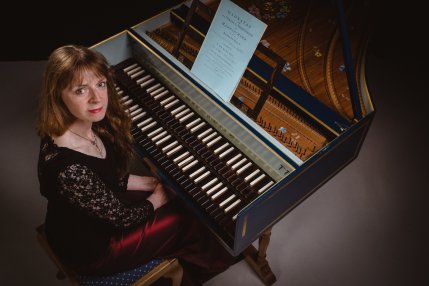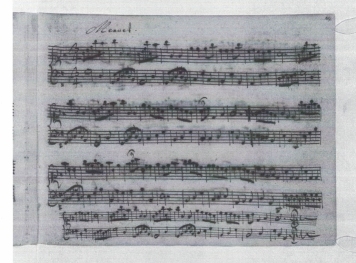Katharine May, who is a British harpsichordist and pianist, is my guest writer today. I asked Katharine (pictured below) for some tips and guidance for those who fancy swapping the piano for the harpsichord, therefore in this post she seeks to explain a few fundamentals. Over to Katharine…
 I have often been approached by pianists wishing to try their hand at the harpsichord, needing some starting points on technique and repertoire. Following on from my brief introduction to the instrument posted in 2016 (you can read this post, here), I thought I would outline some of the harpsichord basics from a practical viewpoint to give readers some confidence and knowledge in understanding this wonderful keyboard instrument.
I have often been approached by pianists wishing to try their hand at the harpsichord, needing some starting points on technique and repertoire. Following on from my brief introduction to the instrument posted in 2016 (you can read this post, here), I thought I would outline some of the harpsichord basics from a practical viewpoint to give readers some confidence and knowledge in understanding this wonderful keyboard instrument.
Touch and Technique
The first, most striking aspect one notices when trying a harpsichord for the first time is the action of the quill plucking the string, and it is the control of this action which helps to determine the quality of the sound produced. Tomás de Santa Maria in c1565 wrote `although the hands strike the keys gently, they nevertheless have to strike them with a little impetuosity`. It might take a little getting used to especially if one is more familiar with the action of a piano, and all harpsichords will feel different, but the trick is to be definite with the fingers and keep them close to the keys. In the first instance, and beginning with a single register (or set of strings, which Francois Couperin recommended in his 1716L`Art de Toucher le Clavecin), try pressing a key very slowly so that you consciously feel the moment when the string is plucked. Notice how long the sound lasts when the finger is still depressing the key, and listen carefully to the moment when the tiny damper cuts off the sound as you mindfully release the key. Control and sensitivity of these movements will greatly enhance articulation nuances, and equally can sound clumsy if mismanaged.
Harpsichord technique is essentially a finger technique – the arm and shoulder are used to maintain a good hand position and help it move over the keyboard and, as Rameau advises, `no great movement should be made where a lesser one will suffice`. Pianists will also invariably notice a difference in key width, length, depth and weight as everything is on a smaller scale. For small hands, this is ideal! Octaves and wide leaps (commonplace in Scarlatti) are somewhat easier, as the distance travelled is shorter but it can also make moving in between the naturals and accidentals more fiddly. Practice some familiar scales slowly using conventional fingering to help you feel more familiar, then take this a stage further by trying some (even all!) the scales using 1-2 fingering throughout, then 1-2-3, and so on, playing as legato as possible. You`ll be surprised how different this feels especially when moving between the naturals and accidentals but it will help to make, and keep, the fingers flexible. This exercise was passed on to one of my teachers, originally from Wanda Landowska. J S Bach`s own teaching method was, apart from scale, arpeggio and ornament exercises, based on using simple pieces. Which brings me to my next topic.
Repertoire to get you going
 Even if readers are highly accomplished pianists, it is best to begin with the simplest dance pieces such as minuets and gavottes. This will enable the focus to be entirely on mastering, or at least understanding the basic touch. And there are hundreds of such pieces available. Try some of the ABRSM List A choices from Grade 1 upwards until you feel reasonably comfortable with the instrument, then you could move onto the Little Preludes of Bach or a selection from the Anna Magdalena Notebook (the original manuscript of one of the pieces in this popular book is shown above). Taking things a step further, have a look at some of the 2, then 3 part Inventions which after all, Bach wrote specifically to encourage a singing style on the harpsichord. Another composer worth exploring at this stage is Henry Purcell who wrote some exquisite pieces for the keyboard which tend to get overlooked today. His many dance pieces are characterful and evocative of 17th century England, while his 8 Suites explore a variety of harpsichord sonorities, though some movements are not quite so easy to the newcomer.
Even if readers are highly accomplished pianists, it is best to begin with the simplest dance pieces such as minuets and gavottes. This will enable the focus to be entirely on mastering, or at least understanding the basic touch. And there are hundreds of such pieces available. Try some of the ABRSM List A choices from Grade 1 upwards until you feel reasonably comfortable with the instrument, then you could move onto the Little Preludes of Bach or a selection from the Anna Magdalena Notebook (the original manuscript of one of the pieces in this popular book is shown above). Taking things a step further, have a look at some of the 2, then 3 part Inventions which after all, Bach wrote specifically to encourage a singing style on the harpsichord. Another composer worth exploring at this stage is Henry Purcell who wrote some exquisite pieces for the keyboard which tend to get overlooked today. His many dance pieces are characterful and evocative of 17th century England, while his 8 Suites explore a variety of harpsichord sonorities, though some movements are not quite so easy to the newcomer.
Accompanying
My concluding section focuses on the art of accompanying since here lies a whole new area to explore with the rewarding benefits of being a more social pastime. Again there is a plethora of music written by a wide range of composers which is very accessible for keyboard players and instrumentalists or singers alike. Originally the accompanist or continuo player would have just a single bass line with figures (or sometimes not!) to read from. This requires a whole new skill which can be daunting for those new to this aspect.
Today, most performing editions come complete with realized keyboard parts, making life perhaps a little easier for some. However, in all my years as a continuo player I have rarely come across a realized part that sounds really stylish, so I`d like to add a few tips and suggestions to the would-be accompanist finding themselves in such a position. Firstly it might be helpful and liberating to know that realized parts usually add far too much in the right hand. As Quantz wrote in 1752 `less is more`. So the most important thing is to follow the bass line and add what you can of the right hand, avoiding playing higher than the melody line, and provide rhythmic support and stability. Adding right hand notes when there is a rest in the left hand is not usually stylish, while adding chords to every bass line note can sound too busy and detract from the solo line. This applies especially to fast movements where there might be numerous passing notes – they certainly don`t all need to be harmonized. If readers are keen to try playing from a figured bass start with a slow sonata movement (to give you more thinking time) by composers whose harmonic language is not too complicated, such as Handel or Vivaldi, and avoid Bach and Purcell until you are more confident. As before, even if you lose your way, just keep the bass line going. While important, the figures are often just giving information rather than instruction and harmony is usually implied by the solo and bass lines combined.
My Publications:
For much more information about how to practice piano repertoire, take a look at my two-book piano course, Play it again: PIANO (Schott). Covering a huge array of styles and genres, 49 progressive pieces from approximately Grade 1 – 8 level are featured, with at least two pages of practice tips for every piece. A convenient and beneficial course for students of any age, with or without a teacher, and it can also be used alongside piano examination syllabuses too.
You can find out more about my other piano publications and compositions here.
from Melanie Spanswick https://ift.tt/2txciVg
No comments:
Post a Comment